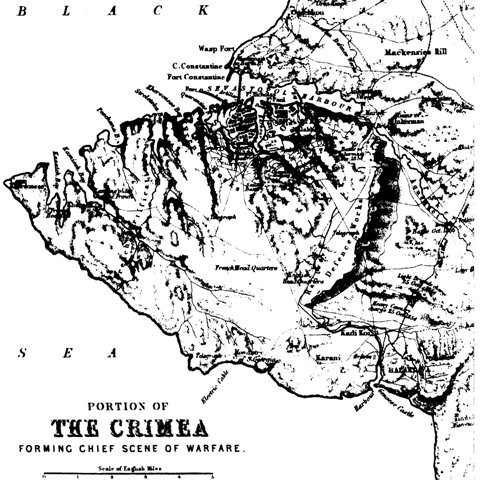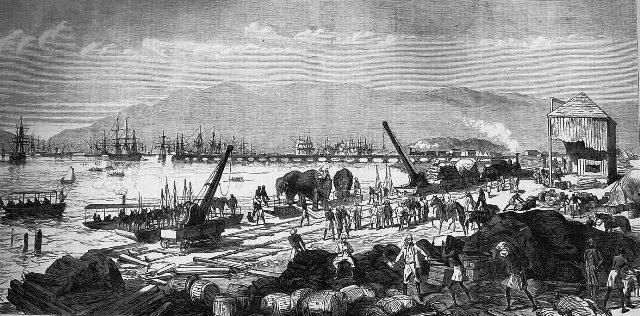
16. TELEGRAPH AT WAR 1854 - 1868
The Crimea
The war with Russia, when Britain and France landed a huge military expedition on the Crimea, a substantial peninsular in the Black Sea, in September 1854 was unusual. Far from being a war of movement it soon settled into being a long-term siege of the city and naval base of Sebastopol.
The Siege of Sebastopol
The Russian city to the north, the British base of Balaklava to the south-east,
the French base of Kamiesch to the west,
the Crimea cable marked to the south at Monastery Bay
(Click on image for larger version, click on Previous Page to resume)
As far as Britain was concerned it was very much a "self-help" conflict with a remarkable series of voluntary initiatives. The railway contractor Morton Peto and his partner Thomas Brassey created a Railway Construction Corps from their own army of labourers and built a full-scale line of rails from the base port at Balaklava to the front line at cost. The mining industry in Leeds contributed two robust locomotives to work it. Joseph Paxton, architect of the Crystal Palace, organised an Army Works Corps to erect a township of wooden huts to protect the troops in the bitter winter. I K Brunel, the railway engineer, designed and had built a huge hospital from prefabricated components. William Fairbairn, the ironmaster and shipbuilder, constructed a pair of floating workshops to undertake all manner of repair and maintenance tasks for the besieging army.
The telegraph companies and their suppliers joined in with this war euphoria. In late 1854, the government in London created a military Telegraph Detachment for the Army commanded by an officer of the Royal Engineers. It was to comprise twenty-five men from the Royal Corps of Sappers & Miners (the army's artisan corps) a cadre of which were trained by the Electric Telegraph Company to construct and work the first Field Electric Telegraph, as it was called.
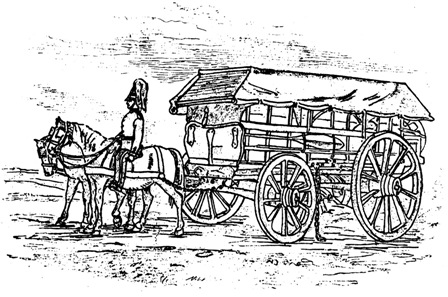
The outfit for the first war telegraph, usually hauled by three pair of horses, it even had a gutta percha boat inverted on the top. The sketch oddly shows a heavy cavalry trooper riding postillion rather than a sapper.
The Telegraph Detachment was equipped with two telegraph wagons. Each was fitted with telegraph apparatus, instruments, batteries, a mole plough, a folding boat, all necessary tools, and drawn by six horses. The man-hauled plough was to lay a light underground cable. All this equipment was designed by the engineer Latimer Clark and made by his employers, the Electric Telegraph Company, at their workshops for the Army. The sappers brought with them twenty-four miles of copper wire insulated with gutta-percha resin for underground and underwater use.
Even before the War Frederick Cadogan, a barrister and a director of the Submarine Telegraph Company, had patented a lightweight army telegraph carriage on October 14, 1853. This had a closed wooden body mounted on a four-wheeled chassis, light enough to be hauled by a single horse in shafts. It contained everything to create and work an electric telegraph.
The body of Cadogan's army telegraph carriage was formed in two compartments. The fore part being a store containing shelves for batteries and apparatus and a long drum the width of the vehicle, on which insulated wire was wound, and from which it was run off to create the line. The roller was propelled by a geared hand-crank and limited by a brake lever. Roller guides were fixed on the roof and within the body to carry the insulated line away. The rear part contained two side seats, with spare cable drums beneath, and a central table for the telegraph apparatus, lit from a windowed door in the back. This part also had a side-hinged roof, lined with reflecting material to give extra light to the interior when opened.
In the field the line wire could be laid by either having the carriage move away from a place with a fixed telegraph paying out the wire, or the insulated wire could be run out and carried by hand. It could be wound back with the crank mechanism. A Manby's mortar, a small cannon, was provided to throw the wire across rivers or similar obstacles.
As well as forming a field electric telegraph it could be used for "firing trains", electrically detonating distant mines and other explosive charges.
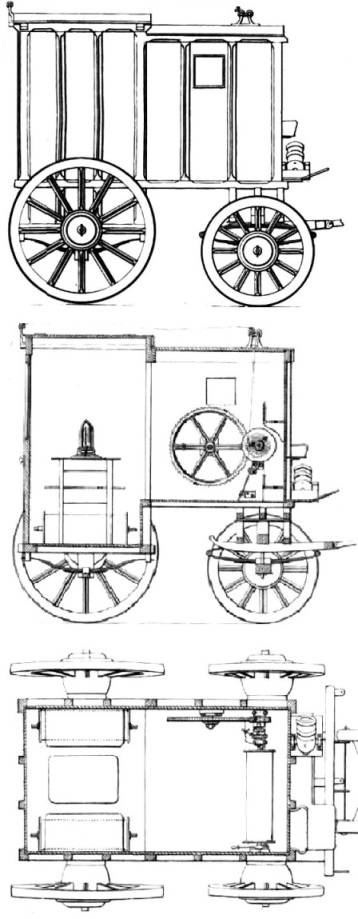
Cadogan's patent army telegraph carriage 1853
Instruments, batteries, insulated wire on three spools and a projector
to shoot the wire over rivers, in one wagon
The instrument shown in the patent drawing is Highton's
single needle telegraph
As T W J Connolly in the 1855 edition of the 'History of the Corps of Royal Sappers & Miners', recorded:
"Two sappers in charge of the Field Electric Telegraph for service in the Crimea, arrived at Balaklava on the 7th December (1854), and repaired to the camp on the 17th, taking with them the instruments, batteries, insulated wire, and appliances, packed in two waggons. Twelve coils of wire, each a mile long, were packed in them, as also a subsoil plough, appropriate tools, and boats. The apparatus is only available for short distances and can be worked by six or eight men. To establish a communication between any two points, the wire, which uncoils from a drum revolving horizontally in a carriage drawn in advance, is laid in a shallow trough made by the plough, which serves the double purpose of cutting the furrow and depositing the line. The trough is just deep enough to protect the wire from ordinary accidents. Equally effective is the apparatus for communication with vessels at sea; and on any sudden removal of the army from one position to another, the wire can be so easily taken up that the men in charge of the telegraph are not likely to be embarrassed in any movements that may be determined upon. The two sappers were specially instructed in the electric telegraph establishment at Lothbury in the mode of working the instruments, laying the wire, and in the ingenious manipulation required to give effect to the process. Such, however, has been the state of the weather from snow, that no opportunity has yet occurred of employing the telegraph; but regarded as an important appendage to the army, Sergeant James Anderson and two privates have since been educated in the art, so that when the time arrives for using it, there will be an adequate staff of operators to attend to its scientific details."
The detachment was commanded from November 1854 by Lieutenant George Montagu Stopford, then from April 1855 by Captain Edmund Frederick du Cane, and finally, on his illness, from September 1855 by Lieutenant A C Fisher. The greatest burden fell on Lt Stopford who supervised the entire construction of the first electric field telegraph, making preparations during the bitter winter months and entrenching the wires in the spring of 1855 between the base at Balaklava and Sebastopol. S J G Calthorpe, a staff officer, was to write in his diary for March 29, 1855, "I have never mentioned to you that a field telegraph, which was sent out here near two months ago, is now in use. Lines have been laid down from Headquarters to Balaklava, to each of our Attacks, as well as to a station between the 3rd and 4th Division camps, and another between those of the 2nd and light Divisions. Lord Raglan (the commander-in-chief) can therefore now communicate in a few minutes with any of his generals at any time, day or night. It is also a great advantage to have it in the trenches, as in the event of any sortie by the enemy, reinforcements can be sent for and instructions asked by the commanding officers in either Attack."
Not everyone was welcoming to the innovation, a journalist reported from the Crimea, "The electric telegraphic apparatus passed up to camp yesterday (December 18, 1854) on two wagons, with thirty miles length of wire covered with gutta percha tubing, accompanied by the necessary implements for placing it sub terra. The first wire will be laid down from Lord Raglan's residence to Balaklava, to communicate with the various departments there. Two india-rubber boats followed the wires, the framework sides folding in, with paddles and sculls slung alongside. No one can imagine how these boats are to be employed, unless it may be for the heads of departments to visit his lordship, should the country be flooded, although from its hilly nature that would be almost impossible, except the deluge may return in Balaklava."
The Telegraph Detachment eventually possessed eight Field Electric Telegraph stations, 24 miles of line around Sebastopol, connecting the Headquarters, Kazach, the Monastery, the Engineer Park, the Right Attack, the Light Division, Kadikoi and Balaklava. It was a rough posting, the Engineer and Light Division stations were billeted in bell tents, the Monastery in a ruined inn, four others in wooden huts and one, the most forward, in a cave.
Each field station had two sappers to work a single-needle instrument, alarm and batteries, with a supply of battery plates and acids. They were assisted by two orderlies from infantry regiments to carry messages. The sappers worked the telegraph by turn, day and night. Sergeant Anderson, the senior non-commissioned officer, was stationed at the Monastery, on the Black Sea coast, receiving the messages from England by way of the submarine line from Varna and relaying them to Headquarters. The Monastery station later also handled the telegraph messages for the Sardinian Army.
At Headquarters, where Corporal Peter Fraser was the chief telegrapher, there were three corporals and three buglers, with three infantrymen acting as message orderlies. The messages to the Commander-in-chief were sent and received in numeric cipher; all other despatches were sent in plain English. Traffic at Headquarters reached a pitch in August 1855 with 402 messages sent and 464 received; that is, respectively, 15 and 13 despatches a day.
The operators, sappers and buglers, were drawn from the ordinary field companies of the Sappers & Miners in the Crimea and taught in the field by Corporal Peter Fraser, who had himself been taught to use the single needle instrument by the Electric Telegraph Company in London. Two of his charges were soon able to read code at a very effective 16½ words a minute. Sappers and buglers each received 1s 0d a day extra allowance for their proficiency and extra duties; and the two sergeants, Anderson and Montgomery, 5s 0d a day.
Pay for sappers working the Field Electric Telegraph was regularised in December 1856: non-commissioned officers in overall charge received 5s 0d per day as an allowance, sappers in charge of stations, 2s 6d, fully-qualified telegraphists 1s 6d, men responsible for batteries and lines 1s 6d and other telegraphists 1s 0d per day extra.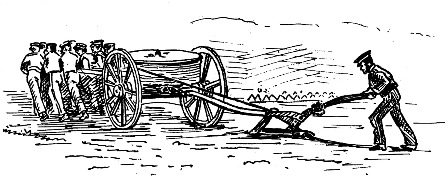
Hauled by soldiers, guided by Sappers & Miners, the device drew off the gutta percha-insulated copper wire from the drum and inserted it underground by means of a hollow or mole-plough
With regard to the practicalities of construction: the plough intended to lay the field cable often failed in heavy, water-logged earth before the city of Sebastopol and the eighteen inch deep trenches then had to be dug and filled by hand. Come Spring the telegraph was opened from Headquarters to Kadikoi, three miles distant, on March 7, 1855 and speedily extended to the siege lines. The gutta-percha insulated line was frequently broken; by troops digging for roots, by traffic, by burials, by shot and shell, by soldiers looking to use the gutta-percha to create tobacco pipe mouthpieces and, in one instance, by a family of mice.
In August 1855 Sidney Alfred Varley, on loan from the Electric Telegraph Company and younger brother of the company's senior electrician, C F Varley, was appointed civil superintendent of the field telegraph and, with ten civil clerks, sent out to work the equipment under Captain du Cane. It was intended to have one sapper and one civilian clerk to each field telegraph station. This proved unnecessary as the sappers worked the line perfectly well, without complaint, and the remaining civilians were soon posted to work the new submarine circuit on the other side of the Black Sea between Varna and Constantinople.
An Electric Telegraph School was opened at the Royal Engineer's depot at Chatham in Kent to train sappers and to maintain the Army's electrical equipment. The course lasted five months.
The British outfitted the Turkish Contingent Force, a mercenary corps, in 1856 with another telegraph detachment. Unlike its own unit this was provided with galvanised wire and lightweight porcelain insulators for attaching to trees and fencing, with only a few miles of gutta-percha insulated underground cable.
Attached was a single Electric Telegraph Wagon. It was intended to connect the several divisional headquarters' of the Contingent when it was in a near- permanent location with ten miles of wire and instruments for two terminal and two intermediate stations. The wagon was part of the First Company of Engineers, in the headquarters' reserve. In addition to communication duties its sappers operated the "Voltaic Apparatus" used to electrically detonate explosive charges.
The Electric Telegraph Wagon was a simple, tarpaulin covered military carriage with four 4¼ foot diameter wheels on india-rubber springs, to be drawn by one or two horses, made by A & E Crosskill in Beverley, Yorkshire, and once again outfitted by the Electric Telegraph Company in London. It contained four cases of equipment: one with tools and spare parts, the second with ten miles of No 16 gauge iron wire, eight sulphate cells, or sand batteries, in gutta-percha containers and the necessary chemicals, the third four single-needle telegraph instruments and four nitric acid batteries in oak containers for detonating charges, the fourth had two miles of gutta-percha covered copper wire on drums and a ladder. Iron wire for the long field circuits was to be used as it was cheaper, was more durable than resin insulated wire, it occupied less space and was easier to re-use. The Contingent's telegraph outfit cost £175, with another £32 for the nitric acid batteries.
The neighbouring French Army initially relied on a version of the Chappe télégraphe aérien or semaphore for its field signalling between the Sebastopol front and its base at Kameisch, but later also laid electric circuits, using the American telegraph.
Sebastopol fell to the French, British, Sardinian and Turkish forces on September 9, 1855. The war formally ended in 1856.

The Monastery of St George near Balaklava, April 14, 1855
The Crimean end of cable to Varna in Turkish Bulgaria seen leading up
from the Black Sea shore to the telegraph station in the Monastery ruins
The Crimea Cable
The Telegraph Detachment
initially also managed the Crimean shore-end of a temporary 310 mile
long submarine cable laid from the Monastery signal station near to
British headquarters in Balaklava to Varna in Turkish Bulgaria. This
connected to the European circuits via a French Army-built land line to
existing Austrian circuits at Bucharest, hence to London and Paris in
autumn 1855. Politicians were thus enabled to interfere with all manner
of military tasks.
The Black Sea cable was constructed by R S Newall & Co., who had laid the first successful submarine telegraph across the English Channel. Newall made his unsolicited proposal to lay a cable at cost to the War Department in London on December 9, 1854. It was accepted on December 12. By January 16, 1855 four hundred miles of cable had been insulated by the Gutta Percha Company in London and shipped to Newall's Gateshead works for finishing, a construction gang of sixty men assembled and a new transport ship chartered! But things then went wrong; the new ship proved unseaworthy and the winter weather was terrible. The cable and equipment had to be transferred to a stronger vessel and only left England on February 25.
Newall's steamer, Argus, carrying his business partner Charles Liddell, his engineer Henry Woodhouse and the Army's Captain E F du Cane, as well as the cable, arrived at Varna on March 30, to be joined shortly by its navy escorts, HMS Spitfire and HMS Terrible.
It was decided to lay the cable from Cape Kaliakria, thirty miles north of Varna to Monastery Bay at Crimea. The little fleet set out on April 1 and completed laying the first war cable on April 13, 1855. The connection at the mainland end was meant to be by a line of overhead wire from Kaliakria to Varna but there was enough cable left for a submarine circuit instead. The Crimean cable made its first message from Balaklava to London on April 28, 1855.
Eventually a Submarine Electric Telegraph Department of the Army was created at the Monastery and Varna. This was drawn from the officers and men of the Royal Artillery rather than the Sappers & Miners. Their training was provided by the Sappers and the work was shared with civil clerks posted from England.Some years later Samuel Alfred Varley was to write, "The cable consisted, throughout the greater portion of its length, simply of one No. 16 copper wire, served with gutta-percha a little less thick than the core of the 1858 Atlantic cable, and wholly unprotected. The shore ends had an iron sheathing, extending to a distance of 10 miles from the Varna shore, and of 6 miles from the Crimean coast. Its insulation was very perfect; and it remained in that condition for nearly twelve months, during the period of the Russian war, notwithstanding the many violent storms to which it was exposed in the Black Sea, until during a storm of more than usual severity, it was broken on the 5th December, 1855."
R S Newall also laid a cable for the British government from Varna direct to Constantinople, the Turkish capital, where another land circuit existed to Vienna and the European capitals. The cables were all worked with the American telegraph to enable compatibility with the continental circuits.
As with Morton Peto and the Crimean Railway, the speedy prosecution and success of the Crimean Cable was to be the pinnacle of R S Newall's career.
After the CrimeaBritain 1856-1862
The Corps of Sappers & Miners, that had effectively worked the electric telegraph in the Crimea in addition to its main function of creating the siege works about Sebastopol, was re-titled the "Royal Engineers" in October 1856, merging with the officer-only corps of that name.
The Army began to adopt the electric telegraph for internal communication in its fortresses; firstly at Malta and then at Gibraltar, to be soon joined by those at Portsmouth, Gosport, Chatham and Plymouth in the late 1850s.
The military telegraph came of age in the
1860s. After its successful introduction the Crimea War of 1854-6 the field
telegraph was utilised by the British Army in India, in China, in New Zealand,
in Afghanistan and in Abyssinia; by the French Army in Italy in its campaigns
at Gaeta and in Lombardy; by the Spanish Army in Morocco; and by the Prussian
and Austrian Armies in Schleswig-Holstein and in Bohemia.
The field telegraph in China followed the headquarters of the advancing expedition many miles inland from the port of Canton. It was erected under the command of Major A C Fisher RE, who had had similar duties in the Crimea and had been the first head of the Army's Electric Telegraph School in Chatham. Its first line was from the harbour and the Navy detachment in Canton to Army headquarters with one intermediate station, a distance of 3,500 yards, laid on April 26, 1858. It was estimated that 25 sappers and 200 soldiers could lay one mile of single-core, gutta-percha insulated cable to a depth of twelve inches in one eight-hour day. The Canton force anticipated using Henley's magneto dial telegraph but found that single-needle instruments had been sent. These required the local production of sulphate batteries, which had not been included in the equipment.

Henley's Portable Military Telegraph
A galvanic single-needle telegraph and galvanometer combined
W T Henley manufactured a simple portable military telegraph that was adopted for field service by the British Army during the 1860s. It was a miniature single-needle galvanic telegraph instrument in a box-like mahogany case. The needle was calibrated so that it could also be used as a galvanometer; and it had two button keys let into the base. It was easily put into circuit with small butterfly nuts on either side of the case, and was carried by a brass ring on its flat top.
This very neat instrument, unlike Henley's magneto-telegraphs widely used in public circuits in Britain, required portable batteries; it could be worked with just two sulphate cells, and used either light iron wire or a resin-insulated field cable for its operation.

Le télégraphe solaire or
héliographe 1855
The earliest heliograph,
invented by Jules Emile Leseurre,
used in Southern Algeria by the French
Army in during 1854 and 1855.
The rectangular mirror is on a swivel or ball
mount.
France 1855-1860
Probably first used in the Crimea, where regular
use of the “mirror telegraph” by the Russians was reported in ‘The Times’ newspaper, during 1855
the French Army in the sun-baked deserts of Algeria was operating several patterns
of télégraphe solaire or héliographe. These had been developed by Jules Emile Leseurre
(1828-1864), one of the government’s inspecteurs des lignes télégraphiques,
to
enable communication over long distances by reflecting the sun’s rays.
There
were three models, the first was in a wooden box 50 cm by 30 cm by 40
cm,
mounted on three short feet, out of which folded an elaborate
two-mirror solar
telegraph with a set of sights, a quadrant and a compass. There was also a very
simple, lightweight single
mirror version with a telescope sight on a tall tripod, with the reflector supported on a
ball-mount at the
end of the sighting tube, weighing in all 2.6 kg. They transmitted the
European Alphabet or dot-dash code. By the 1860s the two-mirror apparatus
had also been made lighter, adding the telescope sight, and set on a tripod. In October 1855 it was
reported
as working over 20 leagues (each 4.45 km). On one “line” between Boghar
and Laghouat
in southern Algeria, a distance of 240 km, three Leseurre solar telegraph posts replaced 23
messenger stations.
It was to be over ten years before other
armies discovered that the heliograph was an inexpensive, portable alternative to the field electric
telegraph.
However, in addition to adopting the heliograph,
the French Empire had learned from observing their allies in the British Army
during the Crimea war. For their brief and bloody campaign in northern Italy
against Austria between May 31 and July 6, 1859 they organised a “service télégraphiques”.
This was formed of civilian staff engaged to follow the army in two “brigades”
of ten waggons. It successfully laid 400 kilometres of line and created
thirty-five telegraph stations along the advance, using light 2mm gauge wire on
6 meter poles, to keep the army in touch with metropolitan France. Each station
was equipped with a portable American telegraph and Marie-Davy sulphate batteries.
Spain 1859-1860
Between October 1859 and April 1860 Spain was at war with Morocco,
with an army under General Leopoldo O'Donnell, extending its interests
into Africa from its ancient enclave of Ceuta. The Royal government in
Madrid commissioned a war telegraph of W T Henley in London. The
largest element was a 25 mile lightweight underwater cable, with a
single No 14 gauge copper core, linking the mainland at Tarifa, near
Algeciras, across the Mediterranean Sea to Ceuta on the Moroccan coast.
It was laid by the steamer Tweedside, which had brought the
cable from London, during the midday hours of December 21, 1859;
on which same day Ceuta was connected electrically with Madrid and the
rest of Europe.
Britain 1863-1866
The British Army created a Telegraph and
Photograph School with the Royal Engineer Establishment at Chatham Depot in
1858. Until 1864 the Chief Instructor in both of these arts was Captain Henry
Schaw RE (1829-1902), a Crimea veteran, who went on to become Inspector-General
of Fortifications. He was succeeded, between 1866 and 1871, in the same
combined role by Captain Richard Hugh Stotherd RE (1828-1895), who was responsible
for “the development and organisation of the equipments for military field telegraphy
and signalling, and in working out a system of defence by torpedoes” in that
position; the telegraph element of the school being also responsible for training
for flag and light signalling, and for submarine mining. Stotherd was to command
the Survey of Ireland and eventually became Director General of the Ordnance Survey.
On October 23, 1862 a detachment of the
Royal Engineers from the Chatham depot forming a surveying party was to embark
for New Zealand. All of its members were to be trained in the use of the
electric telegraph, and “a complete telegraphic apparatus was to accompany
them.”
In 1863 the British Army had standardised its field telegraph equipment. It was still using a portable twelve-cell Wollaston battery, weighing 24 pounds, devised in 1813, although more modern Daniell sulphate cells were also available. For long military lines it used lightweight seven-strand No 22 BWG iron wire tied to earthenware insulators with No 18 gauge iron wire, stapled on to larch poles, 25 to 30 feet in length. For field service it had underground cable of No 16 BWG copper wire insulated with two coats of gutta percha up to No 2 gauge thickness, coated with an anti-rot compound and a cotton serving steeped in tar. The wire and cable was wound on to portable wooden spindles on hand-barrows for easy unreeling.
This light and portable equipment was developed from the Army's experience in using the telegraph in field operations in the Crimean campaign in 1854-6. A dedicated telegraph construction and operating unit was only established in the 1870s – telegraphy was, until then, handled by the sappers of the Royal Engineers as part of their general duties.
During the 1860s there was a continuing dispute between the Royal Engineers and the Quartermaster-General as to which department should operate the field and fortress telegraphs for the Army.
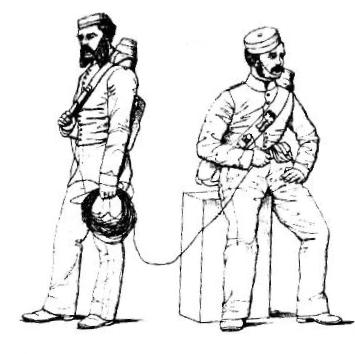
Bolton's Portable Field Telegraph 1863
The battery in a bag on the cross belt, the receiver in the drum
on the left shoulder,
the sending key on the cross belt front
During 1863 Captain Frank Bolton, an Infantry officer, introduced
his Portable Field Telegraph. This was based in principle on the
American sounder or acoustic telegraph, but "carried by one man, in the
form of a set of accoutrements, the indicator on the shoulder, close to
the left ear, the battery in his pouch, and the finger-key, or contact
maker, attached conveniently to the waist belt. With a proper supply of
covered wire, each man would represent a complete telegraphic station
in himself, being able either to send or receive." It was, being so
compact and mobile, a wired 'walkie-talkie'.
The British Army had tested Henley's magneto-electric dial telegraph, developed in 1861, but found that although less complicated than competitive dial instruments Henley's was more "liable to error from unskilful manipulation".
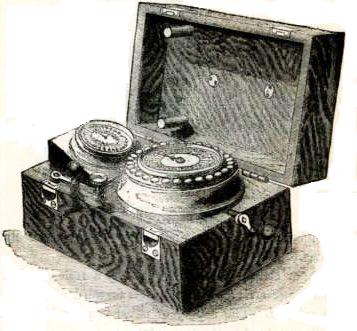
Wheatstone's Universal telegraph 1868
Portable or Military Version
At the same time several sets of Wheatstone's Universal telegraph, also a magneto-electric dial device not requiring any batteries, were purchased by the Army and tested in Ireland. This device was fitted in a small portable case. The Universal telegraph was that first tried on the battlefield by the Imperial French Army in 1859 during their invasion of Italy.
Prussia 1866
Of note was the use of the electric
telegraph by the Prussian Army in 1866 against the Austrians. Four independent
Telegraph Detachments were organised, each carrying 27 ½ English miles of wire
with American printing telegraphs and batteries. The Detachments were able to
lay wire at the speed of a marching column of infantry. One Detachment was
deployed by each of two Army Groups in Bohemia, one was attached to the King of
Prussia’s personal military staff and one was held in reserve. At least two
problems arose with their field telegraph: the wires were insulated in gutta-percha;
this was found (yet again), however well protected, to oxidise and break in
air, to be unsuitable for repeated rolling out and re-rolling, and to be
vulnerable to severing by waggon-wheels. Latterly the wires were suspended from
lightweight poles. Also the field telegraphers rode on horses, this was found
to exhaust them over long distances, special horse-drawn carriages were then provided.
The Prussian Army did not, at this time, use any optical flag or light signals.
Britain 1867-1870
Captain Stotherd, Chief Instructor at the
Royal Engineers’ Telegraph School in Chatham, prepared a plan for a standard
Field Telegraph in 1867, based on the most recent British and continental battle
experience. Each Field Telegraph was to consist of three travelling telegraph
offices and twelve wire and store waggons, carrying 36 miles of insulated wire
and tools, three general service waggons, three artificers’ waggons and a field
forge. There would 245 officers and men in each Field Telegraph, including two
Royal Engineer officers, a surgeon, a veterinarian, 90 sappers and 95 drivers
and signallers; with 145 horses. There were twenty-five fully-qualified telegraphers
in its ranks, including both of the officers.
They were intended for three purposes: to connect an army headquarters with the civil telegraph system; to follow an advancing army forming a line of communication to the rear; and to inter-connect fighting units near to the front.

Military Telegraph Office 1868
The travelling telegraph office was
described by Stotherd in 1870 as being like “a small omnibus” on four wheels
with good springs, being drawn by a pair of horses. It carried two American
register telegraphs on a small table, with two modified Daniell sulphate batteries
beneath the table. It also possessed four other electric telegraphs in reserve;
two more registers as spares and two American sounders for forward field use,
along with two more batteries. It also had a set of Columb’s signal flags and
lights. Completing its load were copper earth plates, a roll of tools for
repairing instruments, a tent, cooking utensils and picket ropes for the
draught horses. It was crewed by three telegraphers, a driver and a spare man
as cook and labourer. The travelling telegraph office weighed when loaded 22
hundredweight or 2,464 pounds, a large load for two horses.
The accompanying wire and stores waggon was
also mounted on four wheels with springs, drawn by four horses, carrying six
wooden drums each with three miles of insulated wire, along with tools and
eighteen lightweight iron poles and a light ladder. The wire was intended to be
laid upon the ground, the iron poles were to carry it over road crossings where
it otherwise might be damaged by traffic. There was a portable ladder that
could extend to 18 feet or fold to form a step-ladder. Underneath was slung a
wheelbarrow on which one of the drums could be fitted and use to pay out wire.
The wire was otherwise paid out from the waggon itself as it moved along the
road. It weighed 32 hundredweight, or 3,584 pounds, and was protected with a
waterproof canvas cover. There was one non-commissioned officer and six men to
each stores waggon. The waggons worked in pairs, one laying wire and one
erecting poles. The wire could be laid at the rate of 2½ to 3 miles per hour.
There was also a process to dismantle the line and rewind the wire onto the drums.
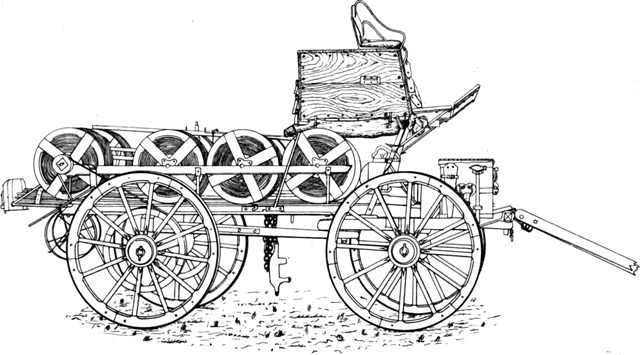
Military Wire and Stores Waggon 1868
Stotherd standardised the electrical equipment of the Field Telegraph to two types of instrument; the American register and the American “sounder”, both made especially durable, coming from one supplier, Siemens Brothers of Charlton, Kent. The sounder and its key, strongly made for field work, were to be used near to the front line. This simplification was based on experience in the field and as the system was generally adopted on the continent of Europe. For the same reasons no delicate instruments were carried, no galvanometers or relays, that might be subject to damage. Stotherd also proposed field use of “Bolton’s Cipher Wheel” for both written and telegraphic messages. Two cipher wheels were later provided to each field unit.
Bolton's Cipher Wheel 1868
Adopted for field use by the field telegraph of the British Army in the 1870s
The wire used was three-strands of No 20
gauge copper insulated with india-rubber to 2/10 ths of an inch diameter,
covered with two thicknesses of tarred cloth tape. It had been severely tested
by being over-run with all manner and weight of waggons. The wire was
manufactured by Hooper’s Telegraph Works Company of Millwall, and by the India-Rubber,
Gutta-Percha and Telegraph Works Company of Silvertown. The ends were fitted
with a weather-proof connector devised by Sergeant-Instructor Mathieson of the
Royal Engineers that allowed their instant joining together.
The light iron poles were in two parts,
fitting one inside the other for travelling. The lower part was 10 feet long by
1 inch diameter with a pointed shoe to be driven into the ground; the upper
part was 9 feet long by 7/8 inches diameter. They were joined together by a bayonet
fitting. A separate wooden “catch” was
added to the tip to carry the wire and two supporting guy-ropes that were
attached to iron ground pickets.
In 1870 Stotherd added a portable boat to
the equipment of each Field Telegraph for use in laying the insulated wire
across rivers.
It must be said that most of this system,
including the portable boat, had been devised by Latimer Clark, engineer to the
Electric Telegraph Company, eighteen years previously, and used by the Army in
the Crimea.
Sir Francis Head, Bt, visited the
Telegraph and Photograph School at Chatham in 1868 and left this description of
Stotherd’s Field Telegraph:
“The travelling telegraph office, in
which as a dealer in lightning wholesale and retail, I sat by myself for several
minutes, ruminating whether I most resembled Jupiter Tonans, or a
common itinerant wizard - is really a curiosity. The sides and doors of this
small chamber (4 feet 3 inches in breadth, and 5 feet 6 inches both in length
and in height) are composed of cedar; its window being shaded by sliding green
curtains.
“The furniture consists of a desk covered
with fine green cloth, on which stood before me two of Morse’s recording
instruments, each about the size of an ordinary drawing-room chimney-piece
clock. Beneath the desk, neatly arranged, and living together in happy communion,
I discovered two electric batteries and two spare instruments. My seat, a
cushion resting on two light white wicker baskets, contained a set of day and
night visual signalling apparatus, a light patrol tent, and a set of cooking
utensils.
“These wicker baskets, packed as above,
and adapted to travel on a pack-saddle, enable the establishment, wherever the
wire-waggon is unable to proceed, of a branch station for visual signalling.
“On the left of the operator or magician,
when seated on this cushion is a cupboard opening by two light thin sliding
doors, containing coils of recording paper, with a signalling apparatus to
enable him to communicate with the men he has detached with the baskets on
pack-saddles; lastly, it contains their kits, accoutrements, and, when on the
march, their provisions.
“At the back of the seat are racks for
the sappers’ rifle carbines and sword bayonets; over the operator’s head are
fixed their tent-poles.
“Outside, on the roof of this conjuror’s
den, high above the two horses that draw it, is a seat and cushion for three
non-commissioned officers, with a large boot beneath to carry the horses’ gear
and driver’s kit; and underneath this boot a compartment, extending the whole
breadth of the carriage, containing a water-barrel, field-stove for soldering,
&c, hammers, a spade, and a few other heavier tools. The whole on springs
with a drag-chain.
“To this little travelling office -
which, weighing when fully loaded only about 20 cwt, is of course easily
drawn by two horses- are attached three non-commissioned officers, each
competent to act as a telegraph clerk, and a driver.
“The wire-waggon, drawn by four
capital short-legged, active horses, conducted by two drivers girded with
swords, and protected by its armed guard of non-commissioned officers and
sappers, is composed of the platform and wheels of an ordinary general service
waggon, on which, as a superstructure, is an elevated driving - seat capable of
carrying three men, having beneath their feet a deal box of the whole breadth
of the waggon, about 2 feet deep and 3 feet broad, containing besides picks and
shovels, the kits of the drivers and their provisions.
“On the platform behind are fixed two
sets, four in each, of revolving drums, around each of which is coiled half a
mile of insulated telegraph wire (making altogether four miles). Reposing
between the two sets of drums lie twenty-four iron tubular poles 10 feet long,
of 1½ inches diameter, each of them
containing within itself another smaller one 9 feet long, which on being drawn
out, can, by a common bayonet-socket arrangement, be firmly fixed to the larger
tube, thus forming a pole of elevation 18 feet high, which is fixed or inserted
in a hole made in the ground by a common crowbar, or “jumper,” driven by a
sledge hammer, and then like the pole of a tent maintained in its place by
three wire-rope guys secured to pegs, similar to those of a tent, excepting
that they are of iron instead of wood, to prevent hungry men burning them for
cooking when short of wood. These poles, which are pointed at the end, are
simply used for road-crossings, to prevent the wire from being injured by the
traffic.
“A common spike, driven into a tree or
wall, may also be used where such supports are available.
“In two instances I saw a sapper, after running up the bars of a very light scaling ladder in two joints, belonging to the waggon, fix it by merely winding it once round a tree. Indeed, as it advances, it can easily be attached to almost any object in its path, and although, as I have described, it is usually elevated on passing a road, yet so efficiently is the wire protected by its thin insulating elastic covering, that waggons, and even a whole battery of guns, have been driven over it on a hard road without injuring it.
The Field Electric Telegraph 1868
Two travelling telegraph offices and two wire and stores waggons
(Click on image for larger version, click on Previous Page to resume)
“The process of laying the wire down, as
I witnessed it, is as follows: -
“Before commencing, three
non-commissioned officers and twelve sappers suspended their rifles to loops on
the sides and rear of the waggon’s driving-box. At the word of command, just as
an actor on the stage suddenly changes his costume, these useful men threw off
their coats, their stocks, and then set to work, which consisted in actively
paying out and fixing in the different ways I have described, the wire as the
waggon proceeded.
“As soon as one of the eight half-mile
coils was expended, I saw it rapidly connected with the wire of another by a
simple and scientific joint... so thoroughly waterproof, that it is now used as
a joint for connecting the electric cables of torpedoes under water.
“When
the wire-waggon with its extraordinary conversational apparatus, from the absence
of roads, or from the presence of bad ones, or of boggy ground, is unable any
longer to proceed, one or more of the eight half-mile coils are carried forward
by sappers on a hand-truck, (it occurred to me that one of these coils might
easily be affixed to a horse’s pack-saddle), and uncoiled by other sappers as
they proceed, the electric communication being maintained by a portable sounding,
hand instrument already described, ingeniously adapted by Captain Stotherd to
be worked by one battery in the waggon, by which arrangement the electrical pulsations
are communicated through the vein or wire from the arterial line, of which the
waggon is the extremity.”
The sappers of the Royal Engineers before 1868 were trained on a range of instruments: the single needle and two needle telegraphs, the American recorder and the American sounder and the Universal telegraph. On these instruments they sent and received the "European Alphabet", except with the two-needle device which had its own code, and the Universal telegraph which worked the common roman alphabet.
The Field Electric Telegraph on exercise at Dover in 1869
showing the travelling office
In July 1868 the 'Quarterly Review' described the Field Electric Telegraph Train that the Royal Engineers maintained at their depot in Chatham, Kent. This consisted of a number of field wagons carrying coils with four miles of insulated copper wire, iron poles, pickaxes and shovels, and several travelling office wagons containing the instruments and batteries, a desk and writing materials. The insulated wire of the Field Electric Telegraph was laid on the surface of the ground, using the light iron poles to carry it over road crossings.
The Field Electric Telegraph practising at Dover, 1869
showing the field wagon laying india-rubber insulated cable
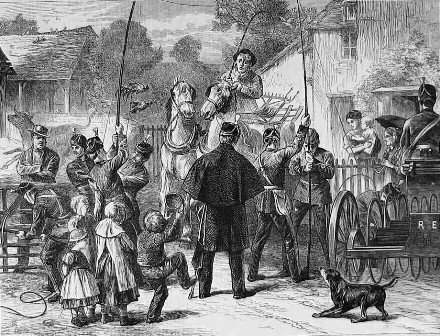
An exercise in laying a Field Electric Telegraph circuit, 1870
An india-rubber insulated cable and lightweight poles over the road
at Blackwater, Camberley
Far away from Chatham the campaign to depose King Theodor of Abyssinia in north-east Africa and to rescue several diplomatists and missionaries from his regime was mounted by the Government of British India at Bombay during the late summer of 1867 and carried out in the spring of 1868. It was to be a massive expedition of European and Indian forces, 13,000 soldiers, 26,000 bearers and 40,000 animals, intending to land on the Abyssinian coast at Zula and proceed inland to Theodor's fortress-capital at Magdala.
The British Indian Army called upon Major John Champain of the Indian Engineers, much experienced in organising the telegraph lines in Persia, to prepare a plan for a Field Telegraph Train to support the expeditionary force. His plan was submitted in September 1867, proposing two services – an "aerial line" to connect the headquarters with the coast, and a "flying line" to connect the headquarters with its outposts. Champain, in Bombay, was only distantly aware of Army developments in England and, to some extent, 'reinvented the wheel'.
The "aerial line" was to allow for 350 miles of line, consisting of bare copper wire to No 16 gauge, weighing 60 pounds to the mile, suspended on 10,000 bamboo poles, eighteen feet tall, without insulators. To traverse forests, by attaching them to trees, and to allow for rare wet or marshy ground, 4,000 light insulators were to be provided. The copper wire would cost £1,000, the insulators, £500. To work this eight of Siemens & Halske's latest American telegraph instruments, as used in India, with portable tables were needed, at £50 each, in total £400, with four tents to house them. One hundred Native Pioneers were to undertake the construction under four European Engineers, and twelve European Signallers were to work the line.
For the "flying lines" between the expedition's field units 50 miles of stranded copper wire insulated with Hooper's india rubber were allowed for, each drum of this to weigh 140 pounds so that two could be carried on a mule. The wire would cost £2,250. To work these mobile circuits twelve Siemens & Halske "sounders" or acoustic telegraphs were to be acquired at a cost of £25 each, £300 in all, requiring the recruitment of twenty European Signallers for their operation.
Lt St John of the Indian Engineers was appointed to command the Field Telegraph Train in Abyssinia and Lt Morgan was to assist him in commanding the European Signallers on the instruments.
In addition to the electric telegraph the Train was equipped with Commander Philip Howard Columb's Flashing Signals, an optical telegraph, as well as flags and heliostats. Two sets of Columb's apparatus were provided by William Nunn, maker of ships' signals and other lamps, of 67 St George Street, London Docks.
The Abyssinian Campaign, with its massive army and elaborate supporting train, which included a light railway and a portable pier or landing stage at Zula, was successful, Theodor being deposed, the hostages rescued and order restored, at a huge material cost. Only 29 British Indian troops were killed, and around 500 Abyssinians. The lightweight or “flying telegraph” was a failure and quickly abandoned, however the long “aerial line” following the Army sent and received 7,848 messages over the five month campaign.
Zula in Abyssinia on the Red Sea, April 1868
A British Indian military base built in a few months,
with a new pier and railways, as well as a telegraph into the interior
(Click on image for larger version, click on Previous Page to resume)
British Outposts 1863-1870
The Army's depots and fortresses at Aldershot, Portsmouth, Malta, St
Helena and Bermuda were all provided with electric telegraph circuits
for internal communication. In July 1868 the Army was also working
telegraphs in Persia.
The longest circuit that the Royal Engineers operated was on the islands of the Bermudas in the mid-Atlantic Ocean, connecting the strategic forts and the navy yard. During 1863 No 5 Company, Royal Engineers, had constructed a single overhead, roadside iron wire from the Central Signal Station at Fort George above St George's, the mercantile port and principal military garrison in the eastern part of the colony, eleven miles west to the Governor's Residence at Mount Langton. By 1866 the line had been extended two miles westwards to Spanish Point and the Admiral's House opposite the Royal Navy yard and fort on Ireland Island. It was completed in 1868 by a 2¼ mile submarine cable to the yard. In 1864 the civil government contributed for its extension with a branch from Mount Langton to the Post Office in the capital of Hamilton. There were eleven military telegraph offices on the Bermudas in 1868, reduced subsequently to nine, most of which were also open for public use.
This system gradually replaced the flag signals that had worked across the islands since the 1820s, which by 1847 had four hill-top posts - at Fort George, with the Central Signal Station for shipping and for meteorological reporting, Mount Langton, Gibbs' Hill, with the colony's lighthouse, and Ireland Island. The flags indicated the arrival and passing-by of shipping and other events, including a midday time signal; the numerical flag code was easily read by the civil residents, who were also allowed to send private messages.

To wind up the story...
a military telegraph cable-drum for subterranean circuits
Telegraph, from the Greek “tele”, distant, and “graphos”, writing
